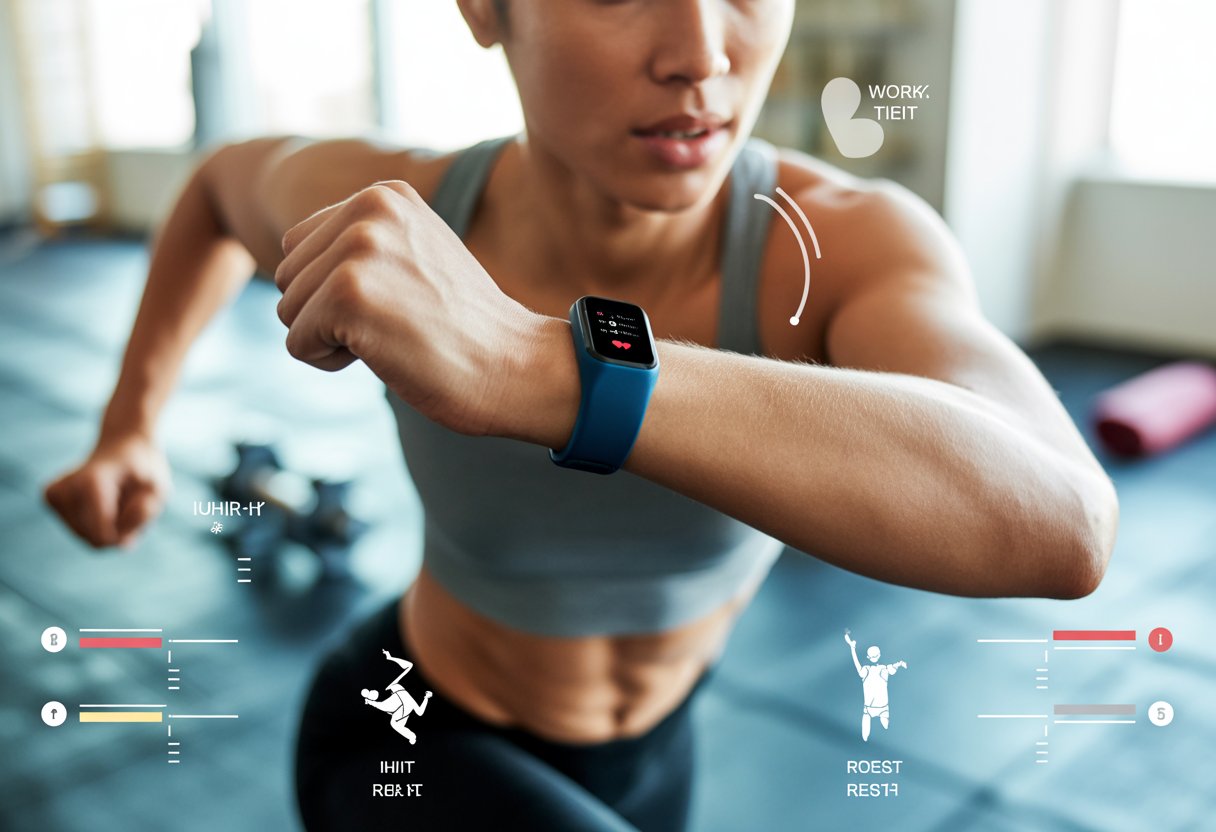HIIT workouts leave us breathless, sweaty, and sometimes a little suspicious that our watch is as exhausted as we are. When we want to track those wild sprints and short breaks, our fitness tracker might just become our new favorite gym buddy.
With just a couple taps, we can log our intervals, check our heart rate, and—let’s be real—maybe brag about our recovery speed. All thanks to that little gadget on our wrist.

It’s kind of amazing how much our tracker can handle, from counting sets to charting our progress over time. No more guessing if we worked hard enough or if our “rest” break turned into a nap—our tracker keeps us honest (and maybe a bit competitive).
Let’s figure out how to really use these handy wrist gadgets and turn our HIIT sessions into data-packed, goal-smashing workouts.
What Is HIIT and Why Use a Fitness Tracker?
So, why is everyone into HIIT workouts, and how do fitness trackers fit in? HIIT is all about giving max effort in short bursts, and tracking that intensity keeps us motivated and—let’s admit it—a bit more accountable.
Understanding High-Intensity Interval Training
High-Intensity Interval Training, or HIIT, feels like the roller coaster of workouts. We push as hard as we can for a short burst, then slow down and catch our breath. It’s basically “sprint like a cheetah, then chill like a sloth.”
A typical HIIT session? Maybe 30 seconds of sprints or jumping jacks, then a minute of slow walking. We repeat the cycle a few times. HIIT works for running, rowing, or just bodyweight moves at home.
Research shows HIIT boosts heart health, burns calories fast, and builds endurance. Plus, these workouts don’t drag on forever—sometimes just 20 minutes. Who really wants to work out for an hour, anyway?
Fitness Trackers vs. Traditional Workouts
With old-school workouts, it’s easy to lose track of how long we’re working, and honestly, sometimes our “high intensity” is more like “meh.” Fitness trackers step in with real-time stats on heart rate, intervals, and calories burned.
These gadgets beep, buzz, and light up, so we’re never left wondering if it’s time to push or pause. Some smartwatches even have built-in HIIT modes that give us automatic timers for both work and rest.
Here’s a quick comparison:
| Feature | Traditional Workouts | Fitness Tracker Workouts |
|---|---|---|
| Manual Timing | Yes | No (Trackers time for us) |
| Intensity Feedback | Guesswork | Precise (heart rate, calories) |
| Motivation | Depends on the day | Reminders & activity goals |
We get more accurate stats and maybe even a few bragging rights with all that data.
Choosing the Right Fitness Tracker for HIIT
Let’s be honest, picking a fitness tracker these days feels like shopping for a new pet. We want something smart, loyal, and preferably not dying halfway through a workout. If we want our HIIT sessions to actually count, the right features and brands make a difference.
Essential Features to Look For
When we’re searching for the perfect HIIT sidekick, accuracy is a must. Our tracker needs to keep up with heart rate changes and react fast during those crazy intervals. Nobody wants their watch to lag behind after every squat jump.
Real-time feedback makes a huge difference. On-screen timers and haptic alerts let us know when to push and when to breathe—no more pretending we’re not tired. Water and sweat resistance is basically non-negotiable. We sweat a lot.
Custom workout modes are a bonus. Some trackers, like the Fitbit, let us add interval or circuit shortcuts right to the wrist, so we’re not stuck fiddling with menus. And honestly, good battery life matters—nobody wants their HIIT to turn into SIT.
Comparing Popular Brands and Models
We’re spoiled for choice, but not every tracker loves HIIT. Garmin offers specific HIIT workout settings, and lets us customize intervals in the Garmin Connect app. We get timers, reminders, and even on-screen workout animations for those days when our brain checks out.
Fitbit’s in the game too. With something like the Charge 4, we can add HIIT, interval, or circuit workouts straight to our shortcuts using the app. Here’s how to do it.
Some wearables just do a better job at HIIT tracking. Here’s a handy list if you want to compare. Just maybe skip the trackers that confuse HIIT with nap time.
Setting Up Your Fitness Tracker for Maximum HIIT Performance
To really get the most out of HIIT, we need our tracker working as hard as we do—ideally with less sweat. Setting up the right workout mode and interval timers saves us time and keeps us on track, even when we’re ready to quit.
Configuring HIIT Workout Modes
Not every tracker speaks “burpee” and “jump squat.” That’s why we need to find the HIIT or interval mode if our device has one. For Garmin users, there’s a built-in HIIT activity mode right on the watch face. We just select it, follow a couple on-screen steps, and we’re set. More tips for Garmin are in the Forerunner 945 manual.
Fitbit lets us add an interval or circuit workout shortcut from the app. We pick our device, add the mode, and we’re ready. If the built-in options are too simple, creating a custom workout gives us more control, as some folks suggest in the Garmin community.
Customizing Interval Timers
No one wants to lose count mid-sprint. Interval timers are our friends. We set the number of rounds, work time, rest time, and even how much we want the tracker to vibrate at us. It keeps us honest and saves us from checking the clock every five seconds.
Most trackers let us tweak these settings in their apps. We can set up, say, 40 seconds of work and 20 seconds of rest, then repeat for as many sets as we (or our coach) can handle. On Fitbit, it’s just a matter of adjusting the interval length in the shortcut. If our tracker doesn’t have a HIIT mode, we can usually name a custom workout “HIIT” so we remember what we signed up for.
Tracking Heart Rate and Intensity During HIIT
When we do HIIT, our heart rate jumps all over the place, and intensity goes from “easy jog” to “run like you’re being chased.” Tracking these numbers with a fitness tracker actually helps us get something out of all that sweat.
Understanding Heart Rate Zones
Let’s be honest: most of us just guess what “working hard” means. Heart rate zones help us stop pretending. Most trackers split things into five zones, which usually look like this:
| Zone | % Max Heart Rate | Feels Like |
|---|---|---|
| Warm Up | 50–60% | “Stroll in the park” |
| Fat Burn | 60–70% | “Mom-speed walking” |
| Cardio | 70–80% | “Mildly dying” |
| Hard | 80–90% | “Why am I doing this?” |
| Max Effort | 90–100% | “911 on speed dial” |
Tracking our heart rate means we know when we’re in the right zone. HIIT focuses on the Hard and Max Effort zones—the ones where our face turns red and our breathing gets dramatic.
To get our max heart rate, we usually just subtract our age from 220. So, for a 30-year-old, “red zone” is about 190 beats per minute. The tracker shows live stats, and honestly, the numbers don’t lie—even if we want them to.
Monitoring Maximum Effort in Real Time
When we’re gasping and questioning our life choices, our tracker suddenly feels useful. During those wild intervals, it shows how close we are to max heart rate. Most trackers alert us when we’re about to max out—or, you know, when it’s time to slow down.
Many trackers let us set custom alerts or display heart rate big enough to see through the sweat. That way, we can see if we’re pushing hard enough or just zoning out. For example, some Garmin watches have HIIT timers that track both intervals and heart rate, so we don’t have to fumble with buttons or make excuses (see how Garmin records HIIT). It helps us measure our effort in real time, instead of just hoping we look busy.
Analyzing HIIT Workout Data
Let’s be real, we’re not sweating just for fun (well, maybe a little). If we want to get better, we need to look at the numbers our tracker gives us after each HIIT session.
That data shows us where we crushed it—and where we just looked sweaty.
Interpreting Performance Metrics
When we check our tracker after a HIIT workout, we usually see a parade of numbers—heart rate, calories burned, intensity minutes, and more. Don’t just scroll by.
Let’s actually look at these key stats:
| Metric | Why It Matters |
|---|---|
| Heart Rate | Shows if we hit our target zones for max results |
| Calories Burned | Tells us our energy use (and maybe justifies that post-workout snack) |
| Active Minutes | Confirms how long we really worked—no cheating! |
If our heart rate spikes and then settles between intervals, we can feel pretty sure the workout was tough enough. These stats give us clear, honest feedback.
If the tracker says we barely burned any calories after a long session, it might be time to double-check its accuracy or maybe tweak our routine.
Using Data to Optimize Your Routine
We can use HIIT stats to tweak our next workout. If our heart rate stays in the “slow stroll” zone, yeah, it’s time to push harder.
On the other hand, if we’re maxed out the whole time, maybe longer breaks (or more snacks) are in order.
Let’s treat our HIIT data like a chill coach. If our heart rate trends down over weeks or we burn more calories in the same time, we’re definitely getting fitter.
Some trackers even show which intervals need work by recording interval times and heart rate patterns.
With all this info, we can fine-tune our plans—boost intensity, adjust rest, or swap out exercises. No personal trainer needed.
Staying Motivated With Your Fitness Tracker
Honestly, keeping up the excitement for HIIT is sometimes harder than the burpees themselves. Our fitness trackers can turn the grind into a bit of a game and help us chase new highs (not just the sweaty, gasping kind, though there’s plenty of that too).
Gamifying Your HIIT Sessions
Why just survive a workout when we can rack up imaginary trophies? Most trackers let us unlock badges, earn streaks, or pile up points for each workout completed.
Suddenly, we’re not just sweating for health—we’re sweating to win.
Let’s make those mountain climbers and squat jumps more interesting by seeing who in our friend group can get the most steps or burn the most calories this week. Loads of fitness tracker apps have leaderboards, so we can compete without explaining why we’re grinning on the floor.
Setting mini-challenges like “complete five HIIT sessions this week” or “beat yesterday’s step count” keeps us coming back. Bragging rights are up for grabs.
If our tracker celebrates us with confetti, even better. Want more tips? JUNK Brands has a few good ones.
Setting Personal High Score Goals
Let’s skip comparing ourselves to internet superheroes and compete against our own past stats. Fitness trackers help us set targets like “finish 20-minute HIIT with a max heart rate over 150” or “burn 300 calories per workout.”
Each session, we can chase the small wins—maybe we held the plank longer, did more reps, or kept our heart rate in the right zone. Jotting stats in a table on our phone or tracker app makes it easy to see progress:
| Date | Workout Length | Calories Burned | Peak Heart Rate | Reps Completed |
|---|---|---|---|---|
| June 1 | 22 mins | 310 | 163 | 120 |
| June 3 | 25 mins | 340 | 168 | 128 |
Watching those numbers climb feels like leveling up in real life—not just in a game. Best part? If we crush our own record, we get to celebrate with a victory snack. No guilt.
Common HIIT Tracker Mistakes and How to Dodge Them
We all want to be HIIT heroes with our trackers, but let’s face it, sometimes we mess up the basics. Here are a couple of slip-ups to avoid so we can track like pros and keep both our gadgets and bodies happy.
Incorrect Wear and Tear
If we let our tracker dangle off our wrist, it’s going to count jumping jacks as jazz hands. The goal? Snug, not strangled.
A loose tracker can’t read our heart rate right. Too tight, and we’re stuck with a “bracelet tan” and zero comfort.
Here’s how to fix it:
- Snug, not tight: Two fingers should fit between tracker and wrist.
- Right spot: About a finger’s width above the wrist bone.
- Keep it clean: Wipe sweat off—nobody likes wrist cheese!
- Workout mode: Switch to HIIT or workout mode so the tracker knows what’s up.
Believe it or not, dirty sensors or worn-out straps send our readings on a wild ride. Swapping broken bands and cleaning sensors is an easy fix.
Let’s be honest—a tracker with no battery and a foggy lens is just fancy jewelry.
Ignoring Post-Workout Recovery Data
We love chasing calorie numbers, but skipping recovery stats is like leaving the movie before the ending. Recovery data tells us how ready our bodies are for the next round.
If we ignore it, we risk overtraining and missing progress. Nobody wants that (except maybe our couch).
Paying attention to heart rate trends, sleep scores, and readiness suggestions helps us dodge extra soreness or fatigue.
Many trackers flag when we need more time to bounce back, but only if we actually check them.
Quick checklist:
- Read the recovery screen after each HIIT session.
- Log how we feel in the tracker app.
- Take rest days—seriously.
Let’s agree to give our bodies (and trackers) a well-deserved break.
HIIT With a Fitness Tracker: Pro Tips and Tricks
We all want to get the most out of HIIT without feeling like we’re hacking into NASA. Using a tracker smartly can make HIIT less confusing and way more rewarding.
Syncing With Fitness Apps
Let’s not kid ourselves—we can’t remember every set, interval, and calorie count. Syncing our tracker with apps like Garmin Connect or Fitbit makes life easier.
We get automatic backups of our sweaty victories, plus colorful charts to prove to our family we actually worked out.
When we finish a HIIT session, syncing our data helps us track progress over time. Heart rate, calories burned, intensity minutes—it’s all there.
Most apps even suggest ways to improve, so we can brag and get better. We can also set up future HIIT workouts, so we know what’s coming next.
Some trackers, like those using the Garmin Connect app, let us customize intervals and rest periods down to the last second.
If we love stats, syncing is our new best friend.
Leveraging Community Challenges
Let’s be honest: a bit of friendly competition always seems to fire up our workouts. When you join community challenges, things just get more interesting.
By jumping into group events or challenges through fitness apps, we get to out-HIIT our friends, coworkers, or even total strangers from all over.
Most trackers toss in leaderboards or monthly HIIT contests right out of the box. We start earning digital badges and watch our names inch up the rankings as we sweat.
These challenges nudge us forward, even after that first burst of excitement fades. It’s also cool picking up new workout ideas from other users, or getting a little encouragement from people who actually get our love-hate relationship with burpees.
So, when you need a little push to go harder—or just want bragging rights—nothing really beats a solid community showdown.
- How to use a fitness tracker for HIIT workouts: Surviving Sprints and Stats Without Losing Your Mind - November 4, 2025
- Best Bluetooth Headphones for Peloton Workouts That Won’t Fly Off Your Head - November 3, 2025
- Why does my fitness tracker app keep crashing? Is It Tired From Tracking My Steps? - November 3, 2025






